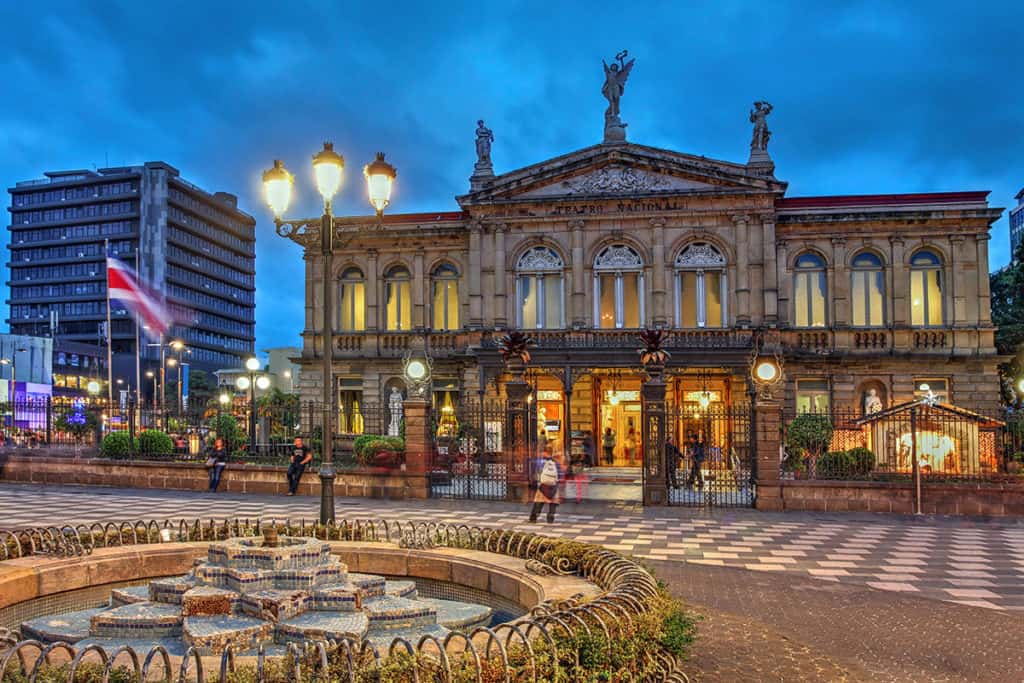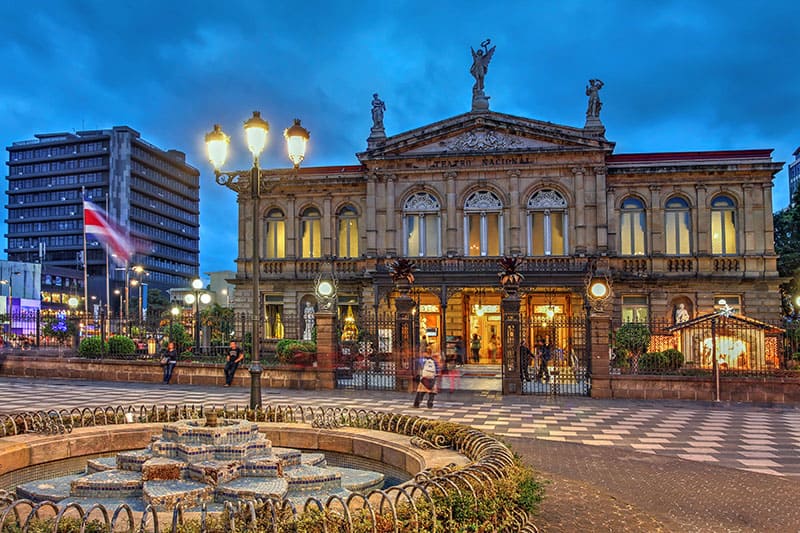
If you’ve ever walked through downtown San José, you’ve probably stopped to admire the National Theatre (Teatro Nacional de Costa Rica). Its grand neoclassical façade, marble staircases, and gilded interiors make it a standout, a symbol of Costa Rican pride.
What you might not know is that this architectural gem owes its existence to the coffee barons who turned Costa Rica’s 19th-century coffee boom into a cultural milestone. Let’s get into the history of this iconic building, how coffee wealth shaped it, and why it remains a must-visit today.
A Coffee Boom Sparks Ambition
In the 1800s, Costa Rica was transformed by coffee. Spanish and Italian immigrants introduced coffee cultivation in the early 19th century, and the country’s volcanic soil, high altitudes, and ample rainfall proved perfect for growing premium beans.
By the 1850s, coffee overtook tobacco and sugar to become Costa Rica’s top export, fueling economic growth. Wealthy coffee barons like Jesús Jiménez, Cristóbal Carranza, and Saturnino Lizano Gutiérrez amassed fortunes, building lavish mansions in San José that still hint at the era’s prosperity.
This coffee-driven wealth didn’t just fill pockets—it sparked a vision for cultural progress. San José, with a population of just 19,000 in the 1890s, was a small capital eager to prove itself on the global stage. The coffee elite, educated and well-traveled, wanted a cultural hub to rival European cities.
The idea of a National Theatre took root, a monument to showcase Costa Rica’s growing sophistication. The project wasn’t just about art; it was about national identity and pride.
From Vision to Reality: The Coffee Tax
In 1891, the push for a National Theatre gained momentum. President José Joaquín Rodríguez Zeledón saw the theater as a way to elevate San José’s status, but funding was a hurdle. His solution? A tax on coffee exports, the country’s economic backbone.
This move wasn’t without controversy—one coffee planter even pleaded to shift the tax to rice and beans—but it worked. By 1893, the coffee export tax was replaced with a general import tax to ease the burden on growers, ensuring broader support.
Coffee barons stepped up with private donations, too. Figures like Lizano, Jiménez, and Carranza gave sums worth millions in today’s dollars, driven by a mix of patriotism and prestige. Their contributions, combined with the tax revenue, covered nearly the entire $140,000 construction cost (about $4.5 million today). The government provided land in downtown San José, but the coffee elite’s generosity made the project possible.
Construction began in 1891, inspired by European opera houses like Paris’s Théâtre Comique. Belgian architect Lucien Rougier and Italian architect Cristoforo Molinari led the design, blending neoclassical and art nouveau styles. Italian engineers were brought in to fix early structural issues, ensuring the building’s durability. Despite setbacks, including the death of a key figure, the theater opened on October 21, 1897, with a performance of Goethe’s Faust.
The Coffee Barons’ Influence

The coffee barons’ role went beyond funding. Their wealth shaped the theater’s grandeur, from its Carrara marble floors to its 22.5-carat gold leaf trim. The façade features statues of Spanish playwright Calderón de la Barca and composer Ludwig van Beethoven, while the entrance walkway honors Frédéric Chopin. Inside, Pietro Bulgarelli’s sculptures of Dance, Music, and Fame greet visitors, and chandeliers illuminate the foyer. The auditorium, with 1,040 red velvet seats, boasts acoustics designed for opera and symphony.
One of the theater’s most famous features is the ceiling mural, Allegory of Coffee and Bananas by Italian artist Aleardo Villa. Painted in Italy and shipped to Costa Rica, it celebrates the country’s agricultural wealth but includes a quirky flaw: bananas are held incorrectly, as Villa never visited Costa Rica. This mural, once featured on the five-colón bill, remains a beloved nod to the coffee era.
The theater replaced the simpler Teatro Mora, destroyed by an 1888 earthquake, and became San José’s cultural heart. Its opening marked a turning point, drawing international artists like Italian soprano Adelina Patti and, later, composers like Igor Stravinsky. The coffee barons’ investment ensured Costa Rica had a stage for global talent, cementing its cultural reputation.
A Cultural Hub Then and Now
Since 1897, the National Theatre has been Costa Rica’s artistic epicenter. In its early decades, it hosted operas, plays, and orchestras, catering to the coffee elite and a growing middle class. The National Symphony Orchestra found a home here in the 1930s, and by 1960, avant-garde works expanded its repertoire. Declared a National Monument in 1965, the theater has welcomed world leaders like John F. Kennedy, underscoring its diplomatic significance.
Today, the theater remains a living landmark. Performances range from classical music to ballet and contemporary theater, with tickets available online or at the box office. Guided tours, offered hourly from 9 a.m. to 4 p.m. in English and Spanish, cost about $7 for foreign adults and are free for kids under 12.
These tours, often led by guides dressed as historical figures, reveal the theater’s history and let visitors peek at rehearsals. The Café Allegro in the foyer serves Costa Rican coffee and light meals, its decor echoing the theater’s elegance.
Renovations in the 1990s, following earthquake damage, restored the theater’s original splendor. Its intricate woodwork, baroque and rococo details, and ceiling frescoes continue to captivate. Visitors can explore the lobby for free, but a tour or performance ticket unlocks the full experience.
The theater’s location in the Catedral district, near Plaza de la Cultura, makes it easy to reach by foot, taxi, or bus, though parking is limited to nearby lots.
Why the Coffee Barons Mattered
The National Theatre’s story is inseparable from the coffee barons. Their wealth, earned through Costa Rica’s coffee boom, funded a project that might have been impossible for a small nation of 20,000. More than that, their willingness to invest in a public good showed a commitment to national unity. Unlike many 19th-century elites, they didn’t just build private estates—they created a shared legacy.
The coffee tax and private donations reflected a collective effort. Teachers, artists, and even housewives contributed small sums, inspired by the barons’ vision. This broad support turned the theater into a symbol of Costa Rican identity, not just an elite playground. Historians note that the shift to a general tax spread the cost across society, making the theater a truly national endeavor.
Visiting the National Theatre Today
If you’re in San José, the National Theatre is a must-see. A guided tour takes about an hour, offering insights into its history and architecture. Catch a performance if you can—check the theater’s website for schedules, as shows vary from ballet to symphony. The café is a great spot to relax with a coffee, surrounded by frescoes and vintage charm. Pair your visit with a trip to the nearby Central Market or Gold Museum for a full day of exploring.
The theater’s story is a reminder of how Costa Rica’s coffee wealth shaped its culture. The barons’ contributions, from funding to vision, gave San José a world-class venue that still shines. Next time you sip a Costa Rican coffee, think of the National Theatre—a monument built on beans and ambition.

